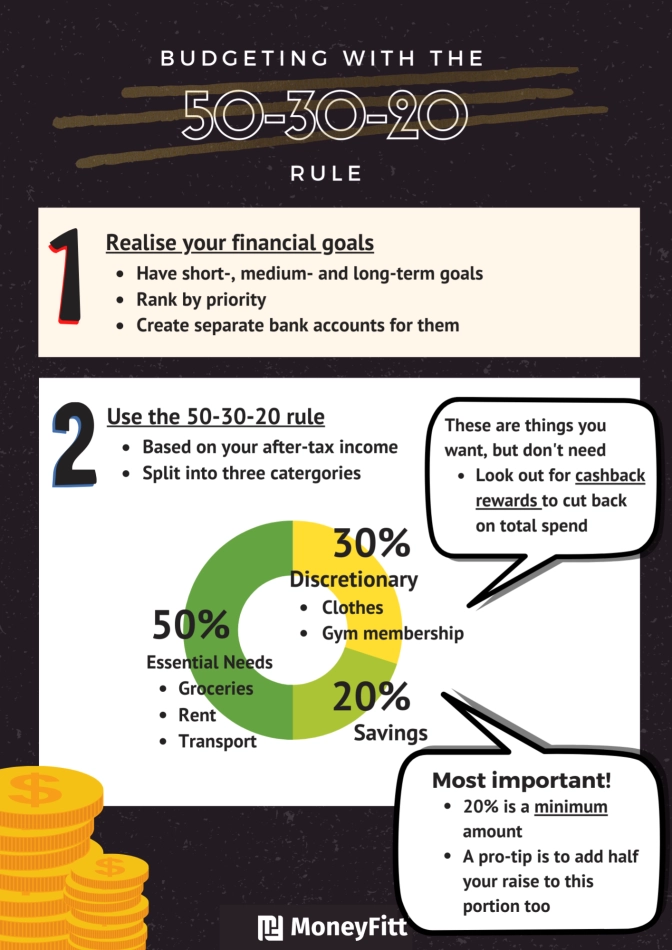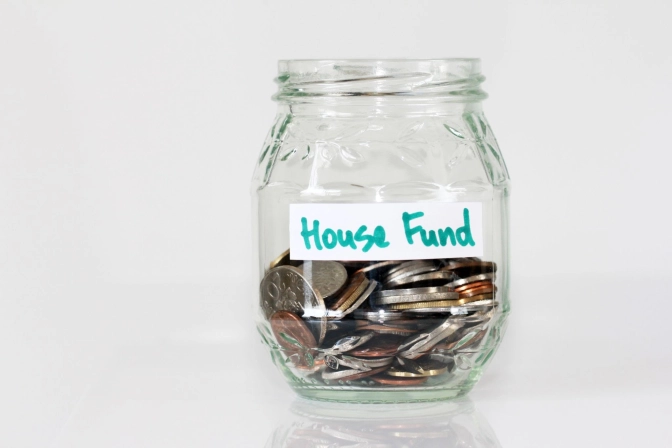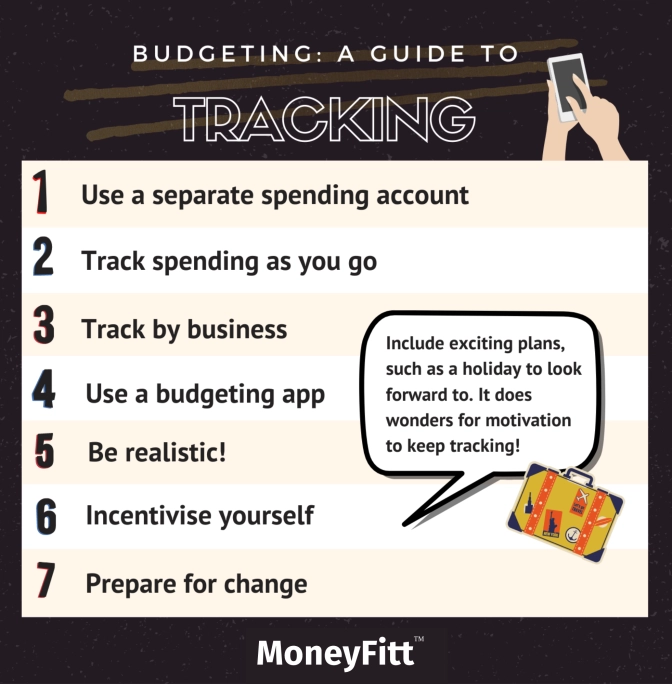Budgeting 101: Why a Strong Budget Is a Catalyst for Financial Freedom
Never have to worry about where all your money has gone a week before payday again!
- A good budget will leave you in a better position to hit your financial goals, prevent you from overspending and in extreme cases, protect you from spiralling into debt.
- When it comes to budgeting, discretionary items are usually optional. It’s easier to cut back on discretionary spending compared to trying to save on essential costs like food and rent.
- But the most essential thing you can budget for is to pay yourself first. Try to set aside 20%, or more, of your take-home pay (after-tax) to reduce any high-interest debt, bolster your emergency fund, invest for medium and long-term goals, and achieve a happy long-term future!
We’ve all been there. It’s only a week until the next paycheck, but you’re running low on funds and have no choice but to scrimp and save to make it till then. You can’t help but wonder, where has my money gone? 🤷🏻♀️

A good budget prevents you from overspending each month and protects you from spiralling into debt. It should also help identify what you can afford each month, helping you stay within your means while helping you save for your future.
That said, creating a budget isn't enough, as you still have to learn to stick to it. To help you nail the proper techniques and disciplines, read on! Following the advice here, budgeting can be easy, leaving you in a better position to hit your financial goals.
How to Budget
Step 1: Realising Your Financial Goals
List your financial goals - categorise them into short-, medium- and long-term goals, rank them regarding priority and create separate bank accounts for them.
Step 2: Set the Goal of Following the ‘Pay Yourself First’ Rule
Many people follow the 50:30:20 rule, a financial rule established by US Senator Elizabeth Warren regarding budgeting. This rule involves dividing your after-tax income into three categories: essential needs (50%), discretionary spending (30%) and savings and investments (20%).
Note - this budgeting system is after tax. Also, this after-tax income should include any other income on top of your salary, such as side-hustle income, interest, investment dividends and welfare payments.
If you live in a country where taxes are not deducted from your income, try to estimate how much tax you would be paying for the current year and set a 12th of that aside monthly.
🚨 Before Reading On
“20% towards savings and investments?! There’s no way I can afford that!” We understand that many of us are struggling with our finances. Don’t worry, as this budgeting rule of ours can be something to aim for.
Ultimately, if you are struggling with your finances as it is, then the basic goal is to improve your ratio. For example, for anybody taking on debt and having a monthly expenditure looking like -5:90:15, just achieving 5:80:15 would be a great start.

Pay Yourself First
The ‘pay yourself first’ rule emphasises the importance of doing the 20% savings and investments part first. This method prioritises long-term saving goals, such as retirement.
By saving first and spending later, you'll have fewer funds available for the remaining period before you get paid again — meaning you're more likely to spend sensibly. With that said, it's important to note that what you are saving for should be of high importance - do not ‘pay yourself first’ if it is for a holiday, especially when you have high levels of outstanding high-interest debt.
Few elements of your budget are guaranteed, and your income, expenditure and lifestyle habits will change over time, meaning your budget may not always perfectly align with the 50:30:20 rule. Hence, we believe the ‘pay yourself first’ approach is more sensible. You should avoid huge monthly variations, but as long as your budget follows this rule over the long term, you'll be on the right track financially.
Savings and Investments (20%)
More than just savings per se, this should also include the repayment of high interest rate debt.

Putting 20% away into your savings and investments first is the target. You may not be able to hit 20% straight away, so try to make a start with whatever you can. Over time, adjust your lifestyle to get there (and beyond)!
I’m Able to Comfortably Put Away 20%, What Next?
Add to it by taking at least half of any raise you get whenever you get one and add it to the original 20% that you started with. Trick your brain by seeing ‘saving more’ as something more positive, like "spending half your raise" instead! You’ll find that the benefits are substantial.
Let’s Run Through an Example
If we assume:
- You get a 3% raise at the start of each year
- You put half of that raise on top of the 20% of your current year's income that's going into savings (or however much you've been able to afford)

This hack automatically increases the total saved yearly as a percentage of income, allowing you to grow your savings while still enjoying most of your income. After all, you’ve worked hard for it!
What to Save for First?
If you’re starting with savings, establishing an emergency fund of three to six months' worth of after-tax income is a sensible goal. After hitting that milestone, you can then focus on longer-term goals such as a retirement fund.
If you intend to start investing, be sure to do your due diligence before investing and be aware of the fundamentals. Investments should suit the time frame of your goal, be diversified to minimise the risk of financial loss and focus on controlling, rather than avoiding, risk.
Essential Needs (50%)
These are bills you must pay and things you basically need to survive (i.e., housing, life insurance, groceries, transport bills, utilities). Although fixed costs may be hard to cut back on, there are usually ways they can still be trimmed, such as by switching your electricity or mobile data supplier. It may be easier to cut down on variable costs.
Not sure where to start? Look at your credit and debit card statements for a rough sense of what you’re spending most on. Don't forget standing and direct debit payments, and watch out for subscriptions - these can quickly add up!
Discretionary Spending (30%)
This part of your income covers things you want but do not absolutely need (i.e. going out to bars and restaurants, vacations, extra clothing). As most of these are optional, logically speaking, this should be the easiest category to cut back on. However, it does take a lot of willpower to keep within budget, as it might mean changing a lifestyle you’re used to. Every choice matters! The saving effect of small choices such as eating in rather than out, choosing public transport over calling a taxi, or even running in the park over locking yourself into a gym membership can make a huge difference.
On top of making good spending decisions, another way to save in this area is to look out for cashback rewards. Many banks and card providers offer rebates, cashback and rewards in return for spending. Finding one that suits you is undoubtedly an excellent way to earn some money back on your discretionary spending!
Track Your Spending

Are you aware of your monthly spending? Chances are, if you don’t track your spending, then you probably aren’t any good at budgeting! Sorry. However, by becoming aware of your spending habits, you can better identify budget issues before it’s too late. Follow these tips to track your finances and budget better.
1. Use a Separate Spending Account
Separating your funds for various expenses is a simple, actionable step to budget better. It’s so easy to open a new account!
2. Track Your Spending as You Go
Before making purchases, be mindful of:
- What bills are coming up and when?
- How much are the forthcoming bills?
- How much of your take-home pay remains?
3. Track by the Business
Are you spending too much of your money in Starbucks when you could be making your coffee at home or your work pantry? Does your furniture need to be luxurious, or can some of it come from IKEA or even "pre-loved" on apps? A few simple swaps of which businesses you buy from can make a big difference.
4. Use a Budgeting App
The millennial’s favourite. These apps are a fantastic way to view all financial information in one place. However, these are only a great way of tracking your expenditure if you remember to open the app regularly! Alternatively, most banks have improved their features, so check the app offered by your main bank.
5. Be Realistic!
Not every expense of yours needs looking at and adjusting. Micromanaging your expenses may even lead to frustration and burnout, so pace yourself, take it easy and seek help, if required, from a trusted financial advisor.
6. Incentivise Yourself
Include exciting plans, such as a holiday, into your tracking.

7. Few Elements of Your Budget Are Guaranteed
Your income, expenditure and lifestyle habits will change over time. Discover your best method of tracking and repeat regularly, to measure success and act appropriately if needed.
BUDGETING 101. COMPLETED. ✅
Sources:
